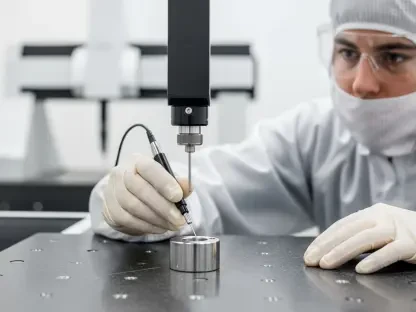Early fault detection (EFD) technology is emerging as a game-changer in both bushfire prevention and the field of advanced manufacturing. Developed by IND Technology at RMIT University in Australia, this innovative solution has the potential to significantly reduce the risk of fires caused by powerline faults, a common issue in many regions, including Victoria. The potential impact of this technology stretches beyond fire prevention, offering promising advancements in the manufacturing sector as well.
The EFD Technology Explained
The EFD system, designed to detect faults in powerlines, can identify and address issues before they lead to catastrophic events such as bushfires. Powerlines are often the source of devastating fires, and this technology provides a proactive approach to mitigate such risks. Advanced sensors and algorithms within the EFD system monitor electrical activity, identifying anomalies that might otherwise go unnoticed until it is too late. By catching faults early, the EFD system enables maintenance teams to intervene promptly, potentially saving lives and property.
In North America, EFD technology has already demonstrated its effectiveness, preventing more than 500 potential fires. This success story underscores the technology’s value proposition and its significance in fire-prone areas like Victoria. The evidence from these regions showcases the transformative potential of EFD technology, particularly in places where bushfire risks are high and the consequences can be dire. With such a track record, the adoption of EFD technology in Victoria and other parts of Australia seems not just beneficial but essential.
Expansion of Manufacturing Capabilities
IND Technology has made a significant leap by expanding its manufacturing facility in Richmond, Australia. This new facility is set to produce over 10,000 EFD devices annually, meeting both local and international demand. The scale of this expansion points to the growing recognition of the importance of EFD technology and the need to ramp up production to meet global market needs. The Richmond facility is equipped with state-of-the-art machinery and staffed by skilled professionals, ensuring the production of high-quality devices.
This expansion is not just about increased production; it also represents a commitment to creating high-tech jobs and reinforcing Australia’s position in the global advanced manufacturing sector. The initiative aims to contribute to economic growth while addressing critical infrastructure issues related to powerline faults. With an expanded facility, IND Technology can also focus on research and development, pushing the boundaries of what EFD systems can do. The creation of high-tech jobs in Richmond not only benefits the local economy but also strengthens the country’s technological and industrial capabilities.
Challenges to Widespread Adoption
Despite the clear benefits and successful trials of EFD technology, broader adoption in Australia has been slow. The complex regulatory environment in the country presents a significant hurdle to the widespread implementation of this innovative solution. Regulatory bodies vary from state to state, each with its own set of rules and requirements for new technologies. This fragmentation makes it difficult to achieve uniform adoption across the country, slowing down the process of integrating EFD technology into the national grid system.
Regulatory approvals and mandates play a crucial role in enabling the deployment of new technologies. Without state regulators’ backing for mandated use or cost recovery through customer billing, the rollout of EFD technology remains limited. The lack of a unified regulatory approach means that even if one state adopts the technology, neighboring states may not follow suit, undermining the potential for nationwide benefits. As a result, the full impact of EFD technology is muted, confined to regions where regulatory and financial hurdles have been overcome.
Successful Trials and Reports
Over the past ten years, IND Technology has conducted extensive trials of the EFD system, co-funded by the Victorian Government. These trials have showcased the technology’s effectiveness in preventing powerline-caused bushfires, demonstrating significant reductions in deployment costs. Detailed field tests and pilot programs have provided ample data to validate the system’s reliability and efficacy, building a robust case for its broader adoption. These trials were strategically placed in high-risk areas, ensuring that the technology was tested in the most challenging environments.
Reports submitted to the Victorian Government highlight the successful outcomes of these trials. Detailed findings illustrate the EFD system’s ability to detect fire-risk network defects reliably and affordably, making a strong case for its broader application. By presenting clear evidence of cost savings and enhanced safety, these reports serve as an essential resource for policymakers and regulatory bodies considering the adoption of EFD technology. The success of these trials has also caught the attention of international markets, leading to increased demand for the devices produced in Richmond.
Regulatory and Economic Complexities
The regulatory landscape in Australia is intricate, with different authorities overseeing pricing and safety. This separation complicates the process of mandating new technologies and recovering costs, creating a significant barrier to the EFD system’s implementation. For instance, safety regulators may see the benefits of EFD technology, but without the support of pricing regulators to allow utilities to recoup costs, widespread deployment becomes financially unfeasible. This division often leads to a lack of coordinated efforts, stalling the adoption process.
In contrast, regions like North America benefit from a unified regulatory framework, which simplifies the adoption of safety technologies. A single regulatory body overseeing both pricing and safety decisions can streamline the introduction of innovations like EFD technology. The disparity in regulatory structures underscores the need for a more streamlined approach in Australia to facilitate the deployment of life-saving innovations like EFD. Without a unified effort, Australia risks falling behind in the adoption of critical safety technologies, putting communities at unnecessary risk.
The Push for Collaboration
IND Technology continues to advocate for greater collaboration between governments, industry, and regulators. Such a partnership is essential to overcome the regulatory challenges and ensure communities benefit from the preventive capabilities of EFD technology. Collaborative efforts can lead to more consistent regulatory frameworks, paving the way for the seamless adoption of innovative solutions. By working together, stakeholders can address financial and logistical hurdles, ensuring that the benefits of EFD technology are realized across the board.
The expansion of the Richmond facility marks a critical step towards meeting global demand and supporting the local economy. However, realizing the full potential of this innovation requires concerted efforts from all stakeholders involved. IND Technology’s commitment to collaboration is evident in its ongoing dialogues with governmental agencies and industry partners. These discussions aim to create a cohesive strategy for the broader adoption of EFD technology, ensuring that communities in fire-prone areas are well-protected.
Potential Benefits for Communities
For communities in bushfire-prone areas, the adoption of EFD technology presents a significant safeguard against devastating fires. Preventing bushfires not only protects lives and property but also contributes to environmental conservation. By mitigating the risk of widespread fires, EFD technology helps preserve natural habitats, wildlife, and plant species that could be irrevocably damaged by uncontrolled blazes. The reduction in bushfire incidents also has economic benefits, reducing the costs associated with emergency response, rebuilding, and insurance claims.
The continued development and deployment of EFD technology align with broader goals of enhancing public safety, economic stability, and environmental sustainability. By investing in such innovations, communities can look forward to a safer future with reduced fire risks. The adoption of EFD technology also serves as a precedent for integrating more proactive and preventive measures into critical infrastructure systems. This forward-thinking approach can lead to the development of additional technologies aimed at preventing other types of natural disasters, further safeguarding communities.
Conclusion
Early fault detection (EFD) technology is revolutionizing both bushfire prevention and advanced manufacturing. Developed at RMIT University in Australia by IND Technology, this cutting-edge solution has the capacity to drastically reduce the incidence of fires sparked by powerline faults, which are a significant problem in many areas, including Victoria.
Powerline faults have been a frequent source of devastating bushfires, leading to considerable environmental and economic damages. EFD technology addresses this issue by identifying potential faults before they result in catastrophic fires. By enabling early intervention, this technology can save countless resources, protect lives, and preserve nature.
Moreover, the implications of EFD technology extend well beyond fire prevention. It holds immense promise for the manufacturing sector, where early fault detection can streamline operations and enhance safety. In advanced manufacturing, the reliability and efficiency of processes are crucial. By detecting faults early, manufacturers can prevent breakdowns, reduce downtime, and improve overall productivity.
Thus, this innovative EFD technology not only helps in addressing pressing environmental concerns but also contributes to the advancement of industrial applications. It represents a significant step forward in both protecting our environment from the dangers of bushfires and in fostering greater efficiency and safety in advanced manufacturing.









